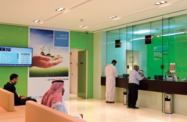The Kingdom’s banks are moving toward the second half of 2011 in a strong position, but their ongoing conservative positions have triggered criticism. Saudi Arabia’s financial institutions are cashed up with healthy levels of liquidity, operating in a secure and growing economy, and have shown new earnings and investment potential. Despite this, there have been calls for the Kingdom’s lenders to be more active in advancing credit, after two years of building up reserves.
Banks’ fundamentals and the business environment are sound. Deposits held by Saudi banks rose by 11% year-on-year in the first three months of 2011, hitting a record high of $286bn, and a recent report by ratings agency Fitch said that local lenders had reduced the average ratio of non-performing loans to around 2.9%, down from the 3.4% at the end of 2009. A number of local and international agencies have upgraded their growth forecasts for Saudi Arabia, with many predicting GDP could expand by up to 6% or more this year, well up on the 3.8% that was previously tipped. At least some of this increased expansion will be driven by new spending programmes unveiled by King Abdullah bin Abdulaziz Al Saud earlier this year, which will see some $130bn of investment in infrastructure, housing, health and the social services sector.
The improved economic climate is encouraging Saudi banks to loosen their purse strings somewhat, with lending to the private sector on the rise. In the first five months of 2011, there was a 4.6% increase in loans advanced to the private sector, the highest rate of growth in the GCC bloc. According to John Sfakianakis, the chief economist at Banque Saudi Fransi, the large state investments and a lack of exposure to real estate-related problems – as happened in other countries across the region – meant the local economy had a better base on which to grow in the period following the global downturn in 2008 and 2009.
“There is a recovery under way, the retailers, the family businesses, they are all benefitting, which is spurring lending from the banks,” Sfakianakis said in comments carried by the Saudi Gazette on July 7. However, there are some in the industry who believe local lenders could be doing more. A report issued by the National Commercial Bank (NCB) said that the high liquidity positions held by the Kingdom’s banks should be used to take advantage of the ample lending opportunities that were presenting themselves.
“Saudi banks will need to redeploy these liquid assets, as the economy has proved to be resilient to external shocks,” the report said.
Tighter lending criteria pushed deposits to expand at a much faster rate than loans, thereby reducing the loans-to-deposits ratio to a six-year low of 71.1%, as of the end of the first quarter in 2011. This reflected the banks’ cautious attitudes toward lending, the NCB study said, though it also noted that the ratio had improved during the second quarter.
Nicolas Hardy, an analyst with Standard & Poor’s, said that a combination of factors, including operating in a protected environment and having the backing of a cash-rich sovereign fund, make Saudi banks among the most profitable, resilient and efficient in the GCC. “Their cost of funding is low due to the high portion of stable, unremunerated deposits. Efficiency ratios are low because of the low cost of labour,” Hardy said in a note issued in early July. “Cost of risk was well-contained and banks had the ability to provide gradually for non-performing loans’ provisions up to conservative levels, that is, up to 100% and higher.”
Already operating from a position of strength, the Saudi banking sector could be given a further boost sometime soon, as and when the long-awaited new regulations governing home mortgages come into force. With estimates putting the potential scale of the mortgage market at up to $240bn – 23% of GDP – within a decade, local banks will have a whole new avenue of investment and profitability opening up before them.
Credit Suisse analyst Mohammad Hawa told local press that the mortgage market will become a major driver of credit growth in a banking sector. “The largest beneficiaries of the growth in the mortgage business will be the banks with highest exposure to the retail segment,” he said in an interview with Gulf News on July 4.
With economic activity set to gain further momentum, as the state’s investment programme stimulates demand and the private sector seeks to cash in on this growth by ramping up its own spending on property and equipment, calls for bank funding will also continue to rise. And, having built up their reserves to record levels, the banks are well placed to shake off their aversion to risk and give credit to the expanding economy.

